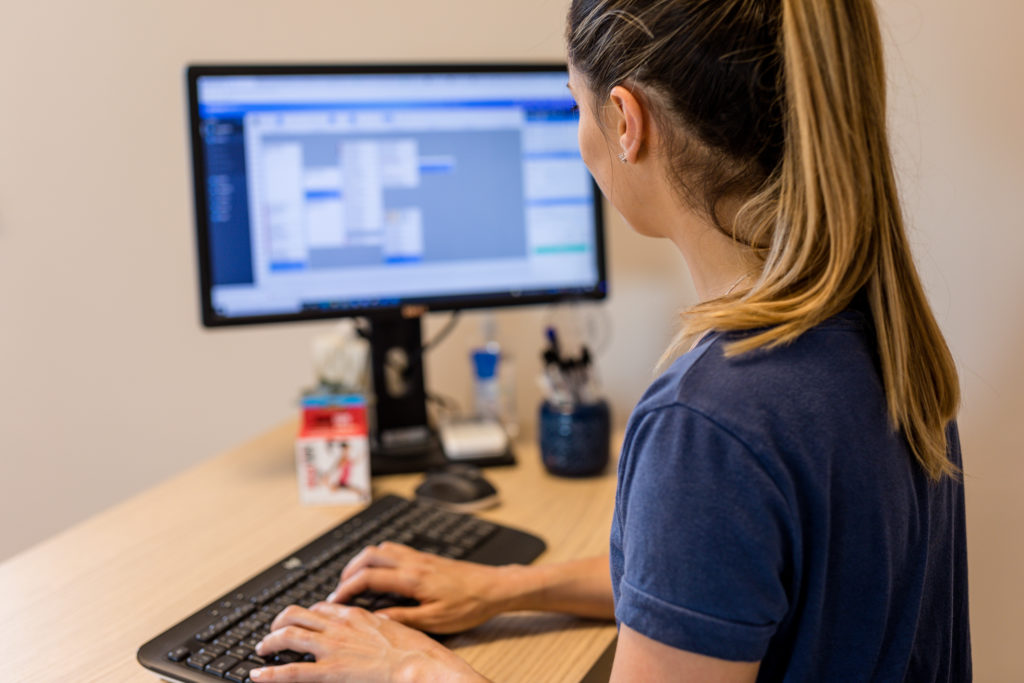Posture and its Importance

I’m sure that most of you who have seen me have heard me talk about the importance of good posture and how it is essential for good health. Even though we can recognise that poor posture is formed because of years of bad habits, only a few of us have a real grasp of the importance and necessity of it.
This week we will be discussing how to sit and stand correctly to avoid injury.

So, what is posture?
Posture is the position in which we hold our bodies while standing, sitting, or lying down. Having good posture means having correct alignment of body parts, which are supported by muscle tension working against gravity. Without posture and the muscles that control it, we would simply fall to the ground.
In normal circumstances, we do not consciously maintain normal posture. Instead, certain muscles groups do it for us. A few muscle groups, including the hamstrings and large back muscles, are essential for maintaining good posture. While our ligaments help to hold our skeleton together, these postural muscles, prevent the forces of gravity from pushing us over.
Why is good posture important?
Here is a brilliant video of the benefits of good posture. https://www.youtube.com/watch?v=OyK0oE5rwFY
Correct posture allows us to stand, walk, sit, and lie in various positions by placing the least amount of strain on supporting muscles and ligaments during movement and weight-bearing activities.
Correct posture helps maintain the following:
- It helps keep our bones and joints in correct alignment, which promotes the correct use of muscles. This, in turn, decreases the abnormal wearing of joint surfaces which over time could result in degenerative arthritis and joint pain.
- It reduces the amount of stress placed on the ligaments holding our spinal joints together, thus minimizing the likelihood of an injury.
- Correct posture allows for a better work efficiency of muscles, which allows the body to use less energy, in turn, preventing muscle fatigue.
- It helps prevent straining, overuse disorders, and even back and muscular pain.
To maintain proper posture, you need to have an adequate amount of muscle strength and flexibility, normal joint motion in the spine and other body regions, as well as efficient postural muscles which are balanced on both sides of the spine. In addition, you must recognize your postural habits at home and in the workplace and work to correct them.
What Causes Bad Posture?
Bad posture isn’t always a sign of laziness. Some of the most common factors contributing to poor posture include stress, pregnancy, weak postural muscles, abnormally tight or weak muscles, and high-heeled shoes. Other factors including decreased flexibility, a poor work environment, incorrect working posture, and unhealthy sitting and standing habits.

How to Sit in front of your monitor
- Keep your feet on the floor or on a footrest, if they don’t reach the floor.
- Don’t cross your legs.
- Keep a small gap between the back of your knees and the front of your seat.
- Your knees should be at or below the level of your hips.
- Adjust the backrest of your chair to support your low- and mid-back or use a back support.
- Relax your shoulders and keep your forearms parallel to the ground.
- Avoid sitting in the same position for long periods of time- Stand up occasionally or do some desk exercises every hour
How to stand properly?
- Bear your weight primarily on the balls of your feet.
- Keep your knees slightly bent- Slightly
- Keep your feet about shoulder-width apart.
- Let your arms hang naturally down the sides of the body.
- Stand tall with your shoulders relaxed and slightly pulled backward- not too far (Just so you are comfortable). I always describe it as though someone is pulling you from the tip of your head and you are elongating your spine
- Tuck your stomach in.
- Keep your head level-your earlobes should be in line with your shoulders. Do not push your head forward, backward, or to the side.
Consequences of poor posture

Sore Muscles
When we slouch, our muscles must work overtime to keep our spine stabilized and protected. The extra work on these muscles results in fatigue. Over time we may experience chronic back issues from tight and sore muscles.
Tension headaches
This is a very common side effect of poor posture; one I see in practice every day. Office workers are predisposed to these headaches simply because too much strain and tension is placed on their bodies from sitting all day.
Spinal Curvature
Bad posture may even result in the development of an abnormal spinal curvature. When bad posture is practiced, increased spinal pressure is experienced, slowly influencing the spine curves to change their positions. Our spine is designed to absorb shock and aid in balance. This feature is slowly compromised as our posture changes.
Spinal restrictions
Once the spinal curve is altered, one major issue that can occur are spinal misalignments. A misalignment occurs when contact between joint surface becomes altered. As with any chain, your spine is only as strong as its weakest link. When one segment is affected the whole spine becomes compromised. These misalignments create stress and irritation on the surrounding spinal nerves.
Blood Vessel Constriction
As bad posture alters the normal alignment of our spine, the resulting movement and misalignments can result in constriction of certain blood vessels. The constriction of these blood vessels can impede the blood supply to the various cells of a muscle, which can affect nutrient and oxygen supply, contributing to the formation of myofascial trigger points.
Nerve Constriction
As the spinal curves undergo a change in shape, the misalignments that develop between vertebrae can put pressure on the spinal nerves exiting the intervertebral foramina. When pressure is placed on these nerves it can cause not only neck and back pain but it may also cause pain in other unrelated areas of the body.
If you have any questions related to posture or if you would like to find out how Physiotherapy care can help, please call 629 444 to book an appointment or email me on Sanchia@bewell.im
Sources:
Association, C.A.C. (2017) Posture. Available at: https://acatoday.org/content/posture-power-how-to-correct-your-body-alignment (Accessed: 18 January 2017).
Team, T.G. (2011) The ultimate guide to good posture. Available at: http://greatist.com/health/ultimate-guide-good-posture (Accessed: 18 January 2017).
Sherwood, C. (2015) Negative effects of poor posture. Available at: http://www.livestrong.com/article/31223-negative-effects-poor-posture/ (Accessed: 18 January 2017).
Grickej, P. (2014) ‘7 most popular tens units on the market’, Tips, 1 July. Available at: http://posturebly.com/5-negative-effects-of-bad-posture-on-your-body-and-mind (Accessed: 18 January 2017).






